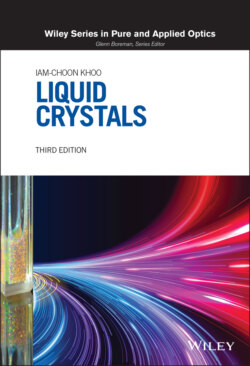Читать книгу Liquid Crystals - Iam-Choon Khoo - Страница 32
2.1.2. Scalar and Tensor Order Parameters
ОглавлениеThe physics of liquid crystals is best described in terms of the so‐called order parameters [1, 2]. If we use the long axis of the molecule as a reference and denote it as , the microscopic scalar order parameter S is defined [1, 2] as follows:
(2.1)
With reference to Figure 2.1, θ is the angle made by the molecular axis with the director axis. The average 〈 〉 is taken over the whole ensemble; this kind of order is usually termed long‐range order. It is called microscopic because it describes the average response of a molecule. The scalar order parameter defined previously is sufficient to describe liquid crystalline systems composed of molecules that possess cylindrical or rotational symmetry around the long axis .
On the other hand, for molecules lacking such symmetry, or in cases where such rotational symmetry is “destroyed” by the presence of asymmetric dopants or intramolecular material interactions, a more general tensor order parameter Sij is needed. Sij is defined as
(2.2)
Figure 2.1. Coordinate system defining the microscopic order parameter of a nematic liquid crystal molecule. Here, i, j, and k are the molecular axes, whereas is the laboratory axis that denotes the average direction of liquid crystal alignment.
where , , and are unit vectors along the molecular axes. With reference to Figure 2.1, the three diagonal components Sii, Sjj, and Skk are given by
(2.3a)
(2.3b)
(2.3c)
Note that Sii+ Sjj+ Skk= 0. Put another way, S is a traceless tensor because its diagonal elements add up to zero.
For a complete description of the statistical properties of the liquid crystal orientation, functions involving higher powers of cos2 θ are needed. The most natural functions to use are the Legendre polynomials P1(cos θ) (l = 0, 1, 2,…), in terms of which we can write Eq. (2.1) as S = 〈P2〉, which measures the average of cos2 θ. The next nonvanishing term is 〈P4〉, which provides a measure of the dispersion of 〈cos2 θ〉.
The order parameters defined previously in terms of the directional averages can be translated into expressions in terms of the anisotropies in the physical parameters such as magnetic, electric, and optical susceptibilities. For example, in terms of the optical dielectric anisotropies Δε = ε‖ − ε⊥, one can define a so‐called macroscopic order parameter that characterizes the bulk response:
(2.4)
It is called macroscopic because it describes the bulk property of the material. To be more explicit, consider a uniaxial nematic liquid crystal such that in the molecular axis system εαβ is of the form
(2.5)
Writing Qαβ explicitly in terms of their diagonal components, we thus have
(2.6)
and
(2.7)
It is useful to note here that, in tensor form, εαβ can be expressed as
(2.8)
Note that this form shows that ε = ε|| for an optical field parallel to and ε = ε⊥ for an optical field perpendicular to .
Similarly, other parameters such as the magnetic (χ m ) and electric (χ) susceptibilities may be expressed as
(2.9a)
and
(2.9b)
respectively, in terms of their respective anisotropies Δχ m and Δχ.
In general, however, optical dielectric anisotropy and its dc or low‐frequency counterpart (the dielectric anisotropy) provide a less reliable measure of the order parameter because they involve electric fields. This is because of the so‐called local field effect: the effective electric field acting on a molecule is a superposition of the electric field from the externally applied source and the field created by the induced dipoles surrounding the molecules. For systems where the molecules are not correlated, the effective field can be fairly accurately approximated by some local field correction factor [3]; these correction factors are much less accurate in liquid crystalline systems. For a more reliable determination of the order parameter, one usually employs non‐electric‐field‐related parameters, such as the magnetic susceptibility anisotropy:
(2.10)
